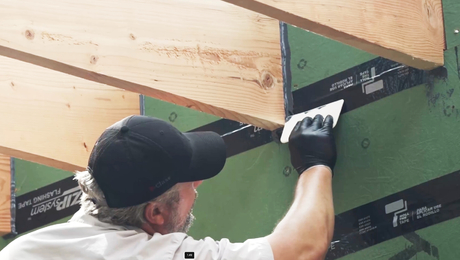We have inch and a half plastic conduit. ? Can we run cable TV, telephone land line, computer ethernet and UF 2-#10 wire all in this same conduit? We are feeding a travel trailer from a 60A sub panel. TT has a 30A pigtail. Also main to 60A sub panel is 65 feet; is #6 OK? How difficult is it to pull solid wires thru’ conduit versus stranded?
Discussion Forum
Discussion Forum
Up Next
Video Shorts
Featured Story

Michael Hindle explores the efficacy of deep energy retrofits and discusses essential considerations for effective climate mitigation.
Featured Video
SawStop's Portable Tablesaw is Bigger and Better Than BeforeHighlights
"I have learned so much thanks to the searchable articles on the FHB website. I can confidently say that I expect to be a life-long subscriber." - M.K.

















Replies
1. From a Code perspectivge, maybe. Depends on the insulation rating of the insulation on the low voltage cables. The low-v cable insulation voltage rating has to be at least as high as the line voltage present in the conduit.
Is it a good idea? No. It's a bad idea. Line voltage cable and phone, CATV, and LAN wiring in close proxinity or actually in contact might lead to 60 Hz signal bleed to the comm cables, depending on the quality of the comm cables and how they were handled during installation.
You'd have the best chance of low interference if you use RG-6 quad shield coax, and Cat 5e or Cat 6 for phone and LAN. And not put too much pulling force on the cables, and not kink them during the pull.
And of course, there's the risk of a line voltage short to one of the low-v cables. Gophers happen. A cross between 120V UF and any of the other wires means blown electronics, and maybe a fire.
2. On the subpanel feeder, it depends on what kind of wire it is (copper or Al) and what type of insulation it has.
3. It's harder to pull solid wire, but whether it's hard enough to matter depends on how many bends there are in the run, as well as the length.
You're going to face a real challenge pulling 10-2 UF in 1.5 inch conduit, even with only two 90s. Three 90s? Forget it. Pull in individual conductors.
Cliff
No, install two conduits, or use direct burial cable.
Thanks guys,
We plan the following......
All the low voltage will now be in the same conduit.
UFB 2 #10s alongside the conduit... direct burial.
15mm copper water pipe in same trench.
Will that work?
That'll work.
However, I
That'll work.
However, I suggest dropping in a second conduit and pulling in copper, THHW-insulated conductors, rather than using DB (direct burial) cable or conductors.
Why? If there's a problem with the wire, it's possible (if not easy) to pull out the old conductors, find the damage, and pull in new, as needed. It depends on the site conditions, but rodents do love to chew on buried wire.
The interesting instances are when there's a nick in the wire insulation of a DB phase conductor and a resulting ground fault, with power leaking to earth, but not sufficient to trip the breaker.
With DB conductors or cable, you have to locate the fault and dig it up and repair it. Locating a fault at the minimum 24" burial depth is not easy, takes some specialized expensive euipment, so often the whole run is abandoned and new wire placed in a new trench. That's not cheap.
Cliff
I haven't checked the code
I haven't checked the code for a while but. it used to be that there was a limited distance shieled cable or romex could be in conduit because of possible heat build up. probably a lot cheaper to run thhn
OK......
2 conduits same trench. All we have is inch and a half.
All the comm in conduit 1.
2-#10s thhn/thwn and a bare #10 ground in conduit 2.
15mm copper same trench.
Solid or stranded? which is cheaper?
Is #6 ok for the 60A feed?
Solid vs stranded price wise is esentially the same. If u don't have it yet the ground doesn't have to be the same size as the two feeds and the neutral for the subpanel. 6 gauge copper is fine for 60 amp subpanel. Again two hot legs and neutral should be #6 ground can be a size smaller.